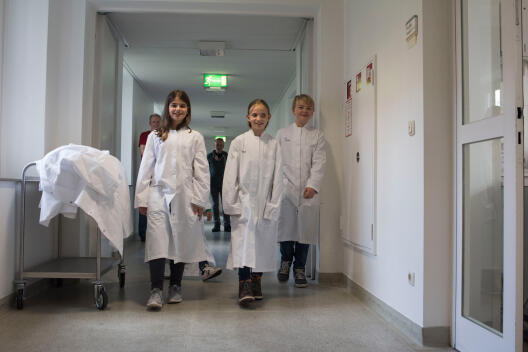Open lab day for families
Photos


In many labs, microscopes are part of the basic equipment. The “junior researchers” were able to take a look for themselves at a variety of cells.© CiM/Jürgen Christ 
How do light microscopes work? The basics can be easily understood if you can bundle and disperse varicoloured lasers yourself.© CiM/Jürgen Christ 
Where do the cells come from that scientists do their research on? How do cells actually live in labs? And what do they eat? In the lab, biology lessons are suddenly much more interesting.© CiM/Jürgen Christ 
You can produce wonderful pictures with yeast. However, “tomorrow’s researchers” have to wait a bit before they can see their paintings in petri dishes – first the yeast culture has to grow.© CiM/Jürgen Christ 
Humans and bananas share about half of their DNA. “Tomorrow’s researchers” were able to isolate banana DNA for themselves, using washing-up liquid, salt, tea filters and skewers.© CiM/Jürgen Christ 
Anyone doing research on viruses needs proper protective clothing. The visitors were also able to test …© CiM/Jürgen Christ 
… what a day working as a virus researcher feels like.© CiM/Jürgen Christ 
Viruses spread fast when people shake hands. Just how fast, is demonstrated by an experiment using fluorescent cream.© CiM/Jürgen Christ 
Biology can be a lot of fun when scientists explain their research topics in an easy-to-understand way.© CiM/Jürgen Christ 
Vaccinations are like protective shields for humans, protecting us against attacks by viruses – symbolized here by balls.© CiM/Jürgen Christ 
A look at the life of a research fish. There are about 40,000 zebrafish swimming around in the aquariums of the Institute for Cell Biology.© CiM/Jürgen Christ 
The “junior researchers” were fascinated and at many places they were able to undertake their own “research”.© CiM/Jürgen Christ
Nearly one hundred "researchers of tomorrow" and their parents came to the labs of the Cells-in-Motion Cluster of Excellence for the "Türöffner-Tag" on 3rd October. They fed cells, wore protective clothing and isolated the DNA of bananas.
Every year, on October 3rd, the children's TV show "Die Sendung mit der Maus" which has been making science fun for almost 45 years promotes a nationwide open day. Several labs from the Cells-in-Motion Cluster of Excellence regularly take part in this event.

